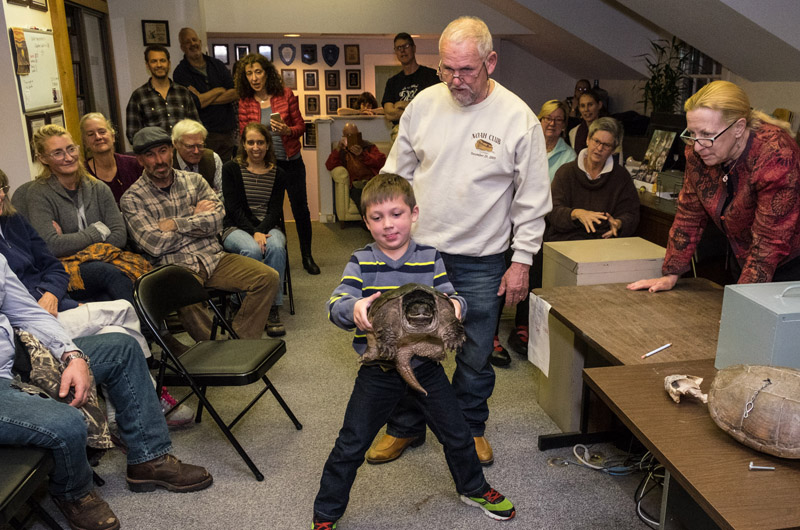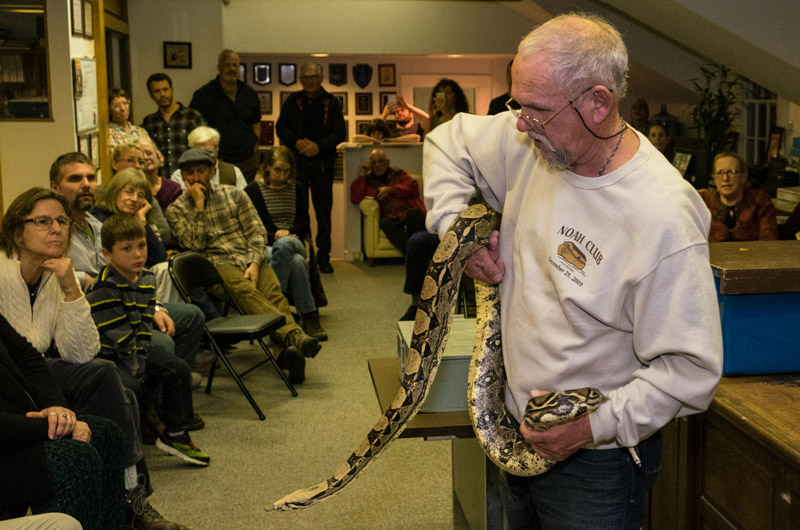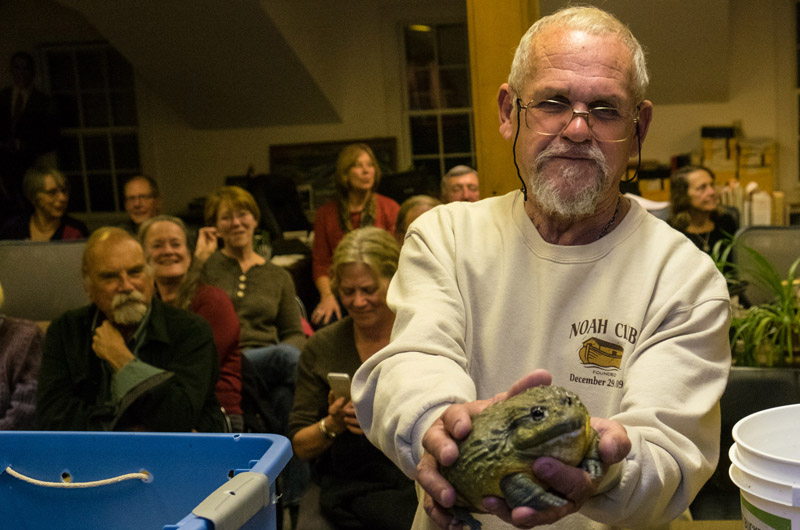Island naturalist Gus Ben David doesn’t name the creatures he rescues and raises — he doesn’t believe in anthropomorphizing animals. But his admiration for all species is loud and clear when he introduces audiences to his menagerie.
“Look at this! Aren’t they something,” he said this week as he placed a large Pixie frog on a desk in the Gazette newsroom. “Let’s take a look at one of these beauties,” he said, cradling a female Eastern box turtle in his hands. “This guy’s absolutely amazing,” he said, hoisting up a 70-pound alligator snapping turtle with powerful jaws and ridges down his back.
Mr. Ben David and some of his wild friends charmed and educated a crowd of about 65 people this week for Tuesdays in the Newsroom, a speaker series hosted by the Gazette. The event was part show and tell, and part free-wheeling discussion about Island wildlife, about which Mr. Ben David is the go-to expert. He was the longtime director of Felix Neck Wildlife Sanctuary and the former owner of the World of Reptiles and Birds, housed at his home. Orphaned or injured animals from around the Island often end up in his care.
Birds of prey are an exception to his no-name rule; a falconer must name them to train and work with them, he said. But his 33-year-old golden eagle, Chameli, was too big to navigate the Gazette’s stairs, and she had to stay in the car on Tuesday evening. Instead, Mr. Ben David brought several animals that live on the Island but are rarely seen, such as salamanders that lurk in vernal pools and snapping turtles that live in the ponds.
While Mr. Ben David demonstrated how snapping turtles use their surprisingly long necks to grab prey, his skilled assistant — grandson Noah, a first-grader at Edgartown school — displayed a year-old snapping turtle barely the size of his palm. Mr. Ben David said that snapping turtles are shy and avoid humans when in the water, but can be extremely aggressive and dangerous on land and are best avoided. He did, however, demonstrate how to pick up a snapping turtle, if the situation arises such as moving the turtle off the road. Because a snapping turtle has such a long and versatile neck, much of it unseen, this should be done very carefully by holding the sides of the shell far away from the turtle’s jaw. Never pick up a turtle by the tail, Mr. Ben David said. It will paralyze him.
A large female box turtle was used to demonstrate the difference between male and female box turtles (one hint: males usually have red eyes, females’ eyes are brown.) And if you see a box turtle, he cautioned, or any other wild animal, don’t try to take them home as pets. Not only are the turtles, and most wildlife, strictly protected, but they also often languish in captivity due to poor nutrition and not enough light exposure.
Mr. Ben David was peppered with questions, including the long-running rumors of coyotes on the Vineyard. He said it has been many years since there has been a confirmed sighting, though coyotes do wash up on the Island, likely from Naushon.
Mr. Ben David made a pitch for the audience to donate to Felix Neck’s campaign to rebuild the barn for Fern and Feather day camp, noting that back in 1990, camper Cory Mello, 13, was the first person ever to find a spotted salamander on the Island, something even Mr. Ben David hadn’t been able to locate, and not for lack of trying. The salamanders are found in just one Vineyard town, Edgartown. One traveled along with Mr. Ben David to the Gazette office on Tuesday.
“No two are alike,” he said, carrying the black salamander with yellow spots around the room.
Mr. Ben David also brought with him a few animals not native to the Island. The audience angled for a view as he carried a Pixie frog around the room. The Pixie frog is native to Africa, and is the second largest frog in the world. It is so big, in fact, that it can’t really jump, and moves about with more of a shuffle.
The show-stopper, a 70-pound alligator snapping turtle, patiently waited in a blue plastic tub. The turtle has a bifurcated tongue that can turn bright red and serves as built-in fishing gear, luring fish to the snapper’s jaws.
“One of nature’s most incredible adaptations,” Mr. Ben David said, using a carrot to demonstrate the turtle’s powerful jaws.
He also marveled at the strength of a small boa constrictor and the contortions of a leucistic black rat snake, which could be tied into a knot.
“They are excellent climbers,” he said.
Snakes make some people uncomfortable, Mr. Ben David acknowledged, and at least one audience member moved away when the boa constrictor was placed on the floor. But Mr. Ben David saw only beauty.
“Gorgeous animal,” he said, as the boa constrictor wound around his arm before slithering back into her box.







Comments
Comment policy »